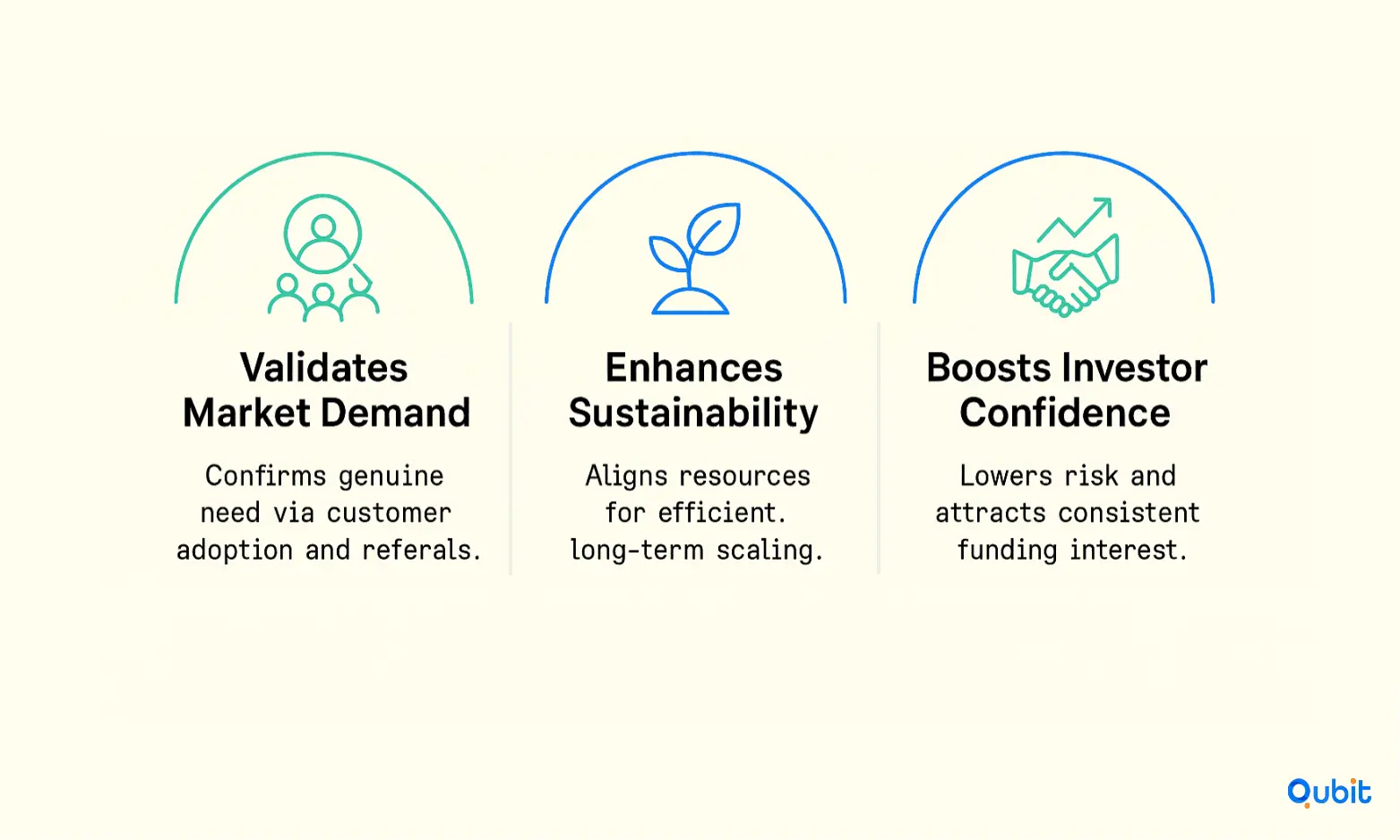Determining whether a product aligns with market needs is a critical step for any business. Assessing product-market fit involves evaluating how well your offering satisfies customer demand while standing out in a competitive landscape. This process not only helps refine your product but also ensures its long-term viability in the market.
An evaluation framework is further detailed through the startup-evaluation-checklist, which outlines practical criteria to assess a startup’s market readiness. By understanding market demand and analyzing competitors, businesses can identify gaps and opportunities that drive growth.
Did you know that 42% of startups fail due to no market need? This guide will explore how to assess product-market fit effectively, focusing on market demand and competition analysis. Let’s jump right in!
Understanding the Critical Importance of Product-Market Fit
Achieving product-market fit (PMF) is often the defining milestone for startups aiming to thrive in competitive markets. It serves as a clear validation of market demand, ensuring that a product resonates with its intended audience. Without this alignment, startups risk exhausting resources on solutions that fail to address real-world needs—a mistake that accounts for 42% of startup failures.

Why Product-Market Fit Matters
1. Validates Market Demand
PMF is the ultimate proof that a product fulfills a genuine need. When customers actively seek out and recommend a product, it signals strong demand. This organic growth, often driven by word-of-mouth referrals, is a cost-effective way to validate PMF. As highlighted in the Organic Growth Trend, startups increasingly benefit from customer referrals, which significantly reduce acquisition costs while bolstering credibility.
2. Enhances Startup Sustainability
Startups that achieve PMF are better positioned to allocate resources efficiently. By focusing on products that meet market needs, businesses can avoid the pitfalls of misdirected investments. This alignment fosters sustainable growth, ensuring that the company can scale without compromising its core value proposition.
3. Boosts Investor Confidence
Investors prioritize startups that demonstrate PMF because it reduces risk and increases the likelihood of long-term success. A product that resonates with its target audience is more likely to generate consistent revenue, making it an attractive prospect for funding.
The Cost of Missing Product-Market Fit
Failing to achieve PMF can be catastrophic. The statistic that 42% of startups fail due to no market need underscores the urgency of addressing this challenge early. Without PMF, businesses may waste time and capital on products that fail to gain traction, ultimately jeopardizing their survival.
Early Detection of PMF Challenges
Identifying PMF challenges early is crucial for avoiding resource misallocation.
Product-market fit is not just a milestone; it’s the foundation upon which sustainable growth and investor trust are built. By prioritizing PMF, startups can position themselves for long-term success while minimizing risks associated with unmet market needs.
Preparing Your Product for Effective PMF Assessment
Achieving product-market fit (PMF) requires more than just enthusiasm for your product; it demands a solid foundation. Before diving into PMF evaluation, two critical elements must be in place: a clear value proposition and a functional minimum viable product (MVP). Skipping these steps can lead to premature conclusions that misrepresent true market demand.
Why a Clear Value Proposition is Essential
Your value proposition is the cornerstone of your product’s identity. It defines the unique problem your product solves and why it matters to your target audience. Without this clarity, even the most sophisticated PMF metrics will fail to provide actionable insights. Collaborating with your team to refine this proposition is crucial. For instance, tools like Google Docs allow for real-time collaboration, enabling teams to draft and refine their value proposition efficiently.
The Role of a Functional MVP
An MVP is not just a stripped-down version of your product; it’s a strategic tool to test hypotheses about your market. A well-designed MVP focuses on delivering the core value your product promises. This ensures that early feedback is relevant and actionable. To streamline the process, consider using Trello to organize user stories and track feature requests. This approach ensures that your MVP evolves in alignment with user needs.
The Risks of Premature PMF Evaluation
Attempting to measure PMF without a clear value proposition or a viable MVP can lead to misleading results. For example, early adopters may provide feedback that appears positive but doesn’t reflect broader market demand. This can result in wasted resources on features or strategies that don’t resonate with your target audience.
To avoid these pitfalls, ensure your product is ready for scrutiny. This involves not only refining your MVP but also conducting thorough due diligence. For a deeper understanding of how to prepare your product for market validation, explore our guide on startup-due-diligence, which outlines the steps for assessing investment readiness.
By prioritizing these foundational steps, you set the stage for an accurate and meaningful PMF assessment.
Key Metrics and Indicators to Validate Product-Market Fit
Determining product-market fit is a critical milestone for any business. It requires a balanced approach that combines both quantitative metrics and qualitative insights to ensure your product resonates with your target audience. By analyzing customer validation, traction metrics, and market research, businesses can gain a clearer picture of their success in meeting market demands.
Quantitative Metrics: Measuring Growth and Retention
Quantitative data provides measurable indicators of product-market fit. These metrics help businesses assess whether their product is gaining traction and retaining customers effectively.
- Growth Rate: A steady increase in user acquisition signals that your product is appealing to a broader audience. Monitor monthly active users (MAUs) and daily active users (DAUs) to track engagement trends.
- Retention Rate: High retention rates indicate that customers find value in your product over time. If users consistently return, it’s a strong sign of product-market fit.
- Lifetime Value (LTV) to Customer Acquisition Cost (CAC) Ratio: This ratio compares the revenue generated by a customer over their lifetime to the cost of acquiring them. A healthy LTV:CAC ratio demonstrates sustainable growth and profitability.
Qualitative Insights: Understanding Customer Sentiment
While numbers tell part of the story, qualitative feedback reveals deeper insights into customer satisfaction and unmet needs.
- Customer Interviews: Direct conversations with users can uncover pain points, preferences, and suggestions for improvement. These insights help refine your product to better align with market expectations.
- Net Promoter Score (NPS): NPS surveys measure customer loyalty and satisfaction by asking how likely users are to recommend your product. A high NPS score indicates strong advocacy and alignment with customer needs.
Combining Metrics for a Holistic View
The most effective way to validate product-market fit is by combining quantitative and qualitative data. For instance, pairing retention rates with customer interviews can reveal why users stay or churn. Similarly, analyzing growth alongside NPS scores can highlight whether new users are enthusiastic about your product.
The discussion on competitive metrics is rounded out by the considerations in evaluate-startup-team, providing a focused look at the impact of founding teams on market success.
Market Research: Staying Ahead of Trends
Market research plays a pivotal role in understanding external factors that influence product-market fit. Competitor analysis, industry trends, and customer demographics provide valuable context for interpreting metrics and feedback.
By integrating these approaches, businesses can validate product-market fit with confidence, ensuring their product is not only viable but positioned for long-term success.
Effective Methods for Measuring Product-Market Fit
Understanding whether your product truly resonates with its target audience requires a combination of qualitative and quantitative approaches. By blending customer feedback with measurable data, businesses can gain a comprehensive view of their product-market fit (PMF).
The Sean Ellis Test: A Key Indicator
One of the most effective tools for assessing PMF is the Sean Ellis Test. This method involves asking customers a simple yet powerful question: "How would you feel if you could no longer use this product?" The goal is to determine the percentage of users who would be "very disappointed" without it. A score of 40% or higher is often considered a strong indicator of PMF. This test provides direct insight into how indispensable your product is to its users.
Quantitative Metrics: Churn Rates and Conversion Analysis
While customer surveys offer valuable qualitative insights, quantitative metrics like churn rates and conversion analysis provide hard data to back them up. A low churn rate indicates that customers are consistently finding value in your product, while conversion analysis helps track how effectively your product attracts and retains users. Together, these metrics paint a clearer picture of how well your product aligns with market needs.
A Holistic Approach
Combining these methods ensures a well-rounded assessment. For instance, the Sean Ellis Test highlights emotional attachment to the product, while churn rates and conversion data reveal behavioral patterns. This dual approach not only measures PMF but also identifies areas for improvement.
Your exploration of product-market fit gains context when considering how to do startup outreach for investors, which intertwines outreach strategies with the broader market landscape.
By integrating both customer feedback and hard metrics, businesses can confidently evaluate their product’s market alignment and make data-driven decisions for growth.
Red Flags: Recognizing the Absence of Product-Market Fit
A product that fails to resonate with its intended audience often leaves behind a trail of warning signs. One of the most glaring indicators of a lack of Product-Market Fit (PMF) is a high customer churn rate. If users consistently abandon your product after a short period, it suggests that the solution doesn’t meet their expectations or needs.
Another red flag is inconsistent growth. While occasional fluctuations are normal, a persistent inability to attract and retain customers points to deeper issues with market alignment. This is often compounded by an over-reliance on heavy discounting to drive sales. While discounts can temporarily boost numbers, they may mask the fact that customers don’t see enough value in the product at its full price.
Negative customer feedback is another critical signal. If users frequently express dissatisfaction or confusion about your product, it’s a clear indication that their needs and your offering are misaligned. Poor social validation, such as a lack of organic recommendations or low engagement on platforms, further underscores this disconnect.
Recognizing these signs early is essential to recalibrate your strategy. Ignoring them can lead to wasted resources and missed opportunities to refine your product.
Clear Indicators: Demonstrating Robust Product-Market Fit
Achieving product-market fit (PMF) is a pivotal milestone for any business, and certain unmistakable signs confirm its presence. Organic growth is one of the most compelling indicators. When users actively recommend your product without external incentives, it demonstrates that your offering resonates deeply with their needs. This kind of word-of-mouth growth is not only cost-effective but also a strong validation of market demand.
Customer satisfaction is another critical measure. Positive user testimonials and high Net Promoter Scores (NPS) reflect that your product is solving real problems effectively. Satisfied customers are more likely to become loyal advocates, further amplifying your reach.
Low price sensitivity also signals robust PMF. When customers are willing to pay a premium for your product without hesitation, it indicates that they perceive its value as indispensable. This willingness to invest underscores the alignment between your product and their expectations.
Retention rates provide yet another layer of insight. A high percentage of repeat users suggests that your product is not just a passing trend but a sustainable solution. Strong retention metrics often correlate with a deep understanding of customer pain points and consistent delivery of value.
Together, these indicators—organic growth, customer satisfaction, low price sensitivity, and retention—paint a clear picture of product-market fit. They collectively validate that your product is not only meeting market demands but also thriving within its niche.
Overcoming Capital Raising Challenges Amid PMF Uncertainties
Securing funding during the early stages of product-market fit (PMF) development often feels like walking a tightrope. Investors are keenly focused on measurable traction, yet early-stage startups frequently face PMF uncertainties that can complicate their fundraising efforts. These challenges demand strategic timing and adaptability to ensure investor trust remains intact.
Timing Matters in Capital Raising
The timing of a funding round can significantly impact its success, especially when PMF metrics are still evolving. Launching a capital raise prematurely—before validating core assumptions—can lead to skepticism from investors. Conversely, delaying too long might result in missed opportunities to scale. Striking the right balance requires startups to assess their current PMF progress and determine whether their product resonates with the target audience.
Strategies to Pivot Amid PMF Failures
When initial PMF efforts fall short, startups must pivot decisively. Here are actionable strategies to address PMF challenges while maintaining investor confidence:
Transparent Communication
Investors value honesty. Clearly articulate the challenges faced in achieving PMF, backed by data and insights from early adopters. Transparency not only builds trust but also demonstrates a commitment to solving problems proactively.Iterative Feedback Loops
Use early customer feedback to refine your product. Investors often appreciate startups that show adaptability and a willingness to evolve based on real-world insights.Highlight Progress, Not Perfection
Even if PMF isn’t fully established, showcasing incremental improvements—such as higher retention rates or improved customer satisfaction—can reassure investors of your trajectory.Reframe the Narrative
Position PMF challenges as opportunities for growth. For example, explain how initial setbacks have led to deeper market understanding and a stronger foundation for future success.
Preserving Investor Trust
Maintaining investor confidence during PMF uncertainties hinges on adaptability and clear communication. By demonstrating a willingness to pivot based on feedback and presenting a roadmap for overcoming challenges, startups can turn potential setbacks into compelling narratives of resilience.
Conclusion
Assessing product-market fit is a critical milestone for any startup, and the strategies discussed here provide a solid foundation for achieving it. By focusing on validated metrics, crafting a robust value proposition, and maintaining a flexible approach to customer feedback, businesses can ensure they are meeting market demands effectively. These elements not only help refine your product but also build a sustainable path for growth.
Taking action is the next step. If you're looking to communicate your product-market fit in a compelling way, our Pitch Deck Creation service is designed to help you craft a winning presentation. Let us assist you in showcasing your product's value and market potential with clarity and impact.
Key takeaways
- Achieving product-market fit is critical for startup sustainability and investor appeal.
- A clear value proposition and a functional MVP are essential prerequisites for accurate PMF assessment.
- Metrics such as churn rates, LTV:CAC ratios, and customer validation are key indicators.
- Early feedback and the willingness to pivot can help overcome capital raising challenges.
- Comprehensive market research and competitive analysis strengthen PMF validation.
Frequently asked Questions
What is product-market fit and why is it important?
Product-market fit means your product meets a significant market need. It is crucial as it lays the foundation for sustainable growth and attracts investor confidence.






